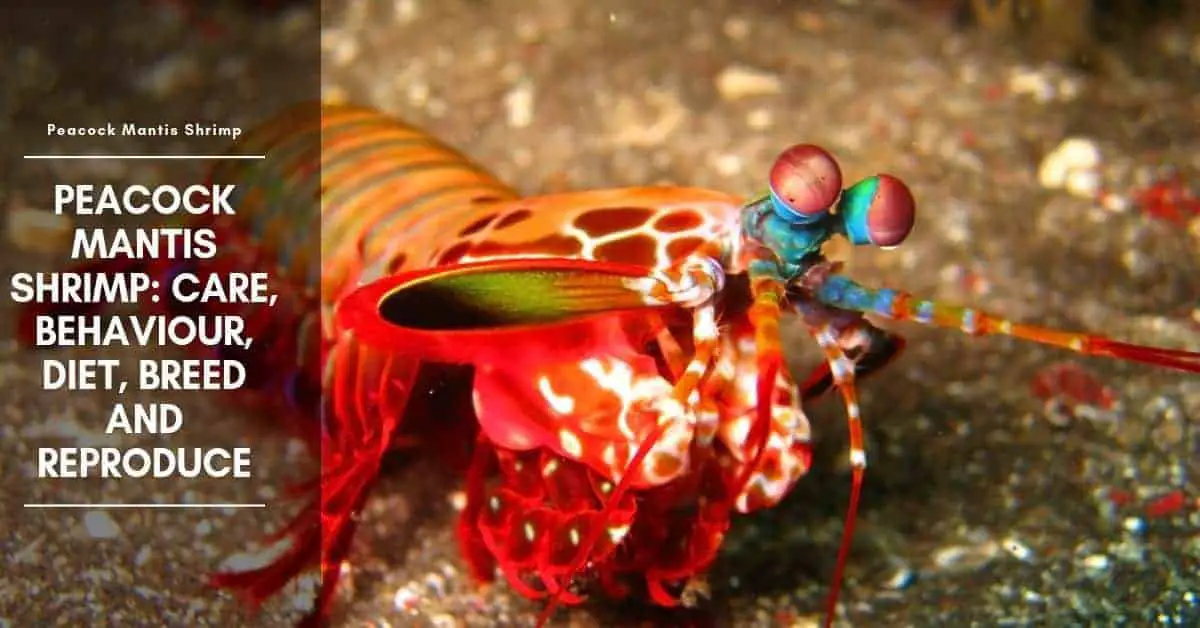Although Peacock Mantis Shrimps are kind of special (because of their looks and behavior), they really aren’t that much bigger than other types of shrimps.
How big is a mantis shrimp?
Peacock mantis shrimp size can be anywhere from 1 to 7 inches. They are not even scary-looking (as far as size is concerned). They do have long and narrow bodies – again, much like regular shrimps.
As for their color, they are very colorful because a mixture of different colors can be found throughout their entire bodies. Those that are mainly green in color have orange legs and they also have spots all over. There are also those that are mainly colored orange and have other mixtures of colors on their shells.
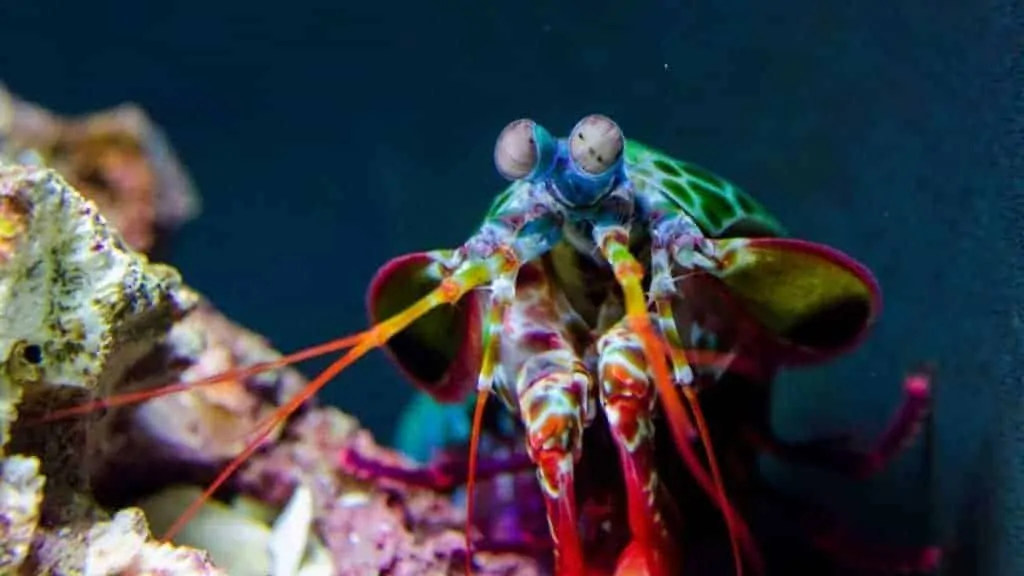
Their appendages or feet are very similar to those of other shrimps. What makes Peacock Mantis Shrimps really special is their club-shaped attachment which is also called a “smasher.”
While the Peacock Mantis Shrimp’s “smasher” can be compared to a boxing glove, it’s much tougher than that. In fact, not only can it hit objects in a very powerful way, but it is also resistant to breakage. Even when the shrimp’s smashers get cracked, they still won’t break easily.
Having a really strong smasher is like having a really large hammer for breaking things. This is also one of the reasons why this type of shrimp is known to be capable of breaking glass tanks when kept as pets.
Another interesting part of the Peacock Mantis Shrimp is its eyes. Their eyes look like two separate attachments on their heads and they can move (and look) in different directions as well.
Known to have a really good vision, the eyes of Peacock Mantis Shrimps can detect movements and colors as well. In fact, studies show that they are even capable of seeing more colors than human eyes.
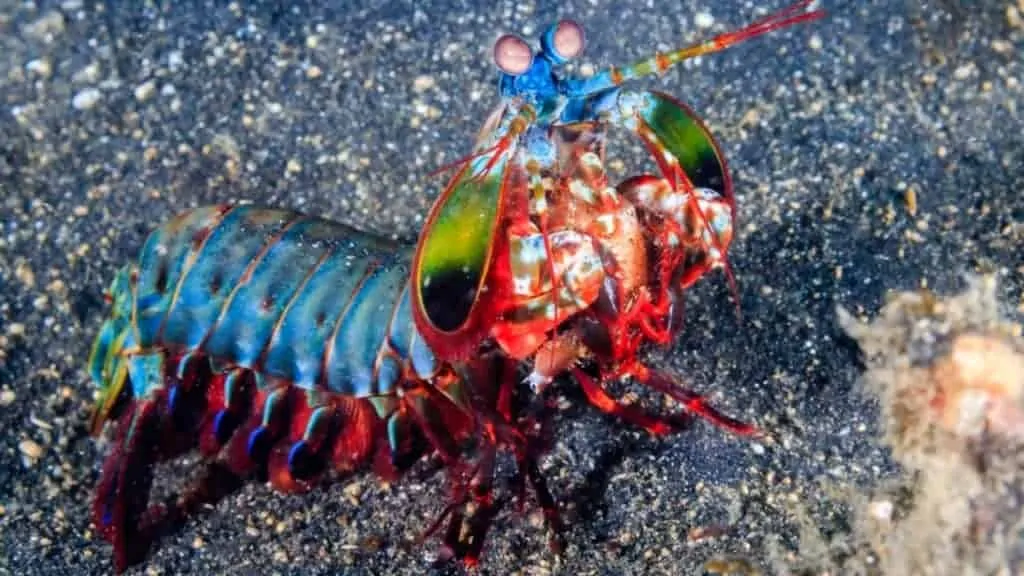
Their eyes are not sensitive to dirt and dust (even though they don’t have eyelids). They can even wipe their eyes (or eyeballs) with their attachments when they get dirty and cloudy. Can you even imagine rubbing your open eyes with your hands? It’s not possible for humans, but it’s acceptable behavior for Peacock Mantis Shrimps.
Aside from the Peacock Mantis Shrimp’s famous clubs or smashers, they also have other appendages or attachments that look like legs. These are indeed considered legs as most of these attachments are used for walking when the shrimp is situated on the ocean floor.
However, there are also attachments that the shrimps use for holding on to objects or prey (their food), and they also use their legs for swimming.
Mantis Shrimp Lifespan
They have a long lifespan if in captivity, however, they don’t live too long in the wild due to predators and human fishing laws. Mantis shrimp generally reach reproductive maturity when they are 2 years old. However, some have been reported to breed at the age of 1 year
Where Can You Find Peacock Mantis Shrimps?
Peacock Mantis Shrimps can be found in a lot of places. They have populations South of Japan, North of Australia, and in Guam to East of Africa.
More specifically, you can find them in coral reefs because they use corals as hiding places. They can also be found in bodies of water that have sand and gravel. They love to burrow and dig the ocean floor to hide and to find food.
Peacock Mantis Shrimps also have preferences when it comes to the depth and temperature of the waters they live in. Usually, they can be found in depths of about 10 to 130 feet deep. Their ideal temperature is about 72 to 82 Fahrenheit (22 to 28 degrees Celsius).
API STRESS COAT Aquarium Water Conditioner 16-Ounce Bottle
29% OffAPI STRESS ZYME Freshwater and Saltwater Aquarium Cleaning Solution 16-Ounce Bottle
API ACCU-CLEAR Freshwater Aquarium Water Clarifier 4-Ounce Bottle
13% Off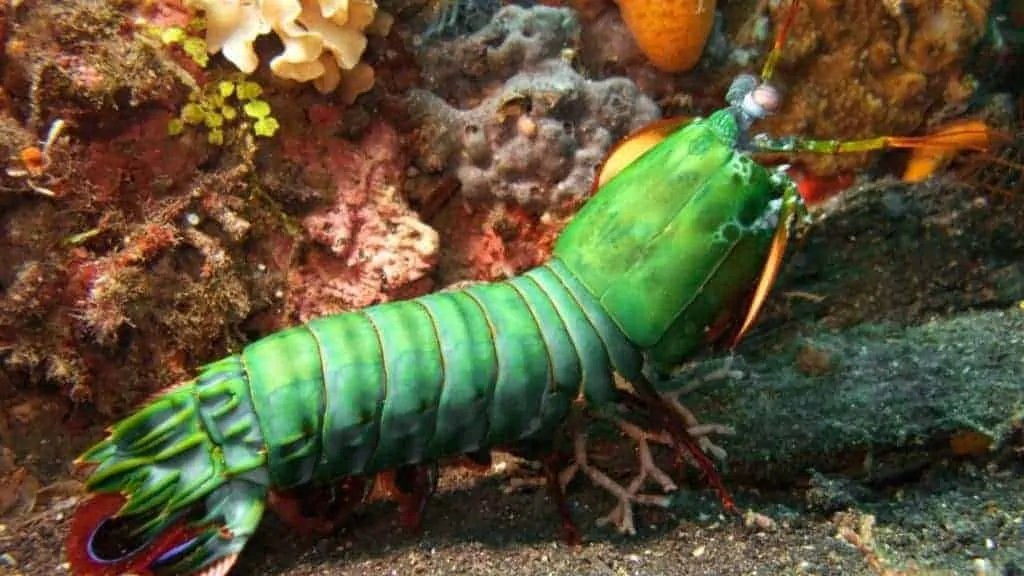
Mantis shrimp facts
- Mantis shrimp have 16 strike muscles.
- They are considered to be aggressive and territorial toward intruders or those that invade their territory.
- Mantis shrimp use their claws for hunting, defense, feeding and digging burrows.
- The mantis has eyes on stalks (much like a lobster) which allows it to see predators from different directions as well as hide when needed. It can even rotate its head in all directions!
- The mantis shrimp has 3 claws. Two large ones are used for hunting/defense and one small raptorial claw. When they are opened, they have a green spot in the middle of the claw that is used when killing prey or for stunning. It may also be used as an infrared sensor
- The female mantis shrimp can carry over 20,000 eggs at one time.
- In mating season, the male mantis will use his stalked eyes to identify its mate and then release pheromones that cause her to breed with him in order to ensure he doesn’t waste his sperm on her. After fertilization, she will carry the eggs for 1 to 2 months until they are ready to hatch.
- The mantis shrimp will lay her eggs in a burrow-like environment and cover them with sand. As mentioned above, there can be as many as 20,000 eggs for each female!
How Do Peacock Mantis Shrimps Behave?
As sea creatures that are called “burrowers,” Peacock Mantis Shrimps dig holes in the ocean floors. They can also live among rocks and corals — and if this is the case, they will smash corals and rocks to make caves in them.
Peacock mantis shrimp punch
Their special appendages are called “smashers” because they can smash things with their clubs. They use their clubs as fists, so they can knock out other animals by punching them. Basically, they use their punching skills to kill prey (live food).
Since they mostly feed on crustaceans (hermit crabs, shrimps, etc.), their main goal is to destroy their outer shells so that they can gain access to the animals’ soft tissues and flesh.
Did you know that the Peacock Mantis Shrimp even holds the record as the fastest puncher of all living animals? That’s how fast they move when they need to knock out things. In fact, the speed of their punch is even compared to a .22 caliber gun — it’s like being hit by a bullet when this shrimp strikes on an object (or an animal).
As hunters, they go about their routine both day and night. They are active hunters — so they will go after their prey instead of just waiting for them.
A mantis shrimp punch is so powerful that it can shatter the windows of a small aquarium. The cracking sound produced by the strike was so deafening that one team researching them found (through experimentation) they could temporarily deafen crabs and kill sea snails by delivering the strike nearby.
In addition, it also causes blinding light to be emitted for about 7 minutes, making it even more difficult for prey to escape unnoticed.
What’s worse? This type of punch isn’t just an arm motion – these crustaceans can deliver up to 50 strikes per second with each blow packing about 3000 kilojoules which is equivalent to an Audi fastback hitting you at 115 miles/hour (185 km/h). Imagine
Peacock Mantis Shrimps are also solitary sea animals. You will seldom find them in groups as they are alone most of the time. Typically, you will only find them in pairs when it’s mating season.
Their day-to-day routine is simply to hunt and look for food. When they’re not doing this, they are usually resting in their holes or burrows.
Keep in mind that their senses are very good — especially their sense of sight and sense of smell. Basically, they always know what’s going on around them and are always ready to defend themselves from predators (predators are animals that eat Peacock Mantis Shrimps).
They are also territorial — this means that they don’t want other sea animals (even other shrimps) to stay within their territory. If there are other sea creatures near their homes, they will use their smashers to fight with them and send them away.
Does a mantis shrimp punch hurt?
It depends on where it punches you. If it punches a human in the face, for example, yes – you will most likely be knocked out. For other places like the kneecap or elbow joint, no…you won’t feel much pain.
What Do Peacock Mantis Shrimps Eat?
Peacock Mantis Shrimps eat a wide variety of food that can be found in the sea. Crustaceans are among their favorites, so they love eating crabs and even fellow shrimps.
Crabs will usually fight with them first, but with the Peacock Mantis Shrimp’s smasher, it can easily defeat a crab. Not only can a Peacock Mantis Shrimp knock off the claws and legs of a crab, but it can also even break its hard shell.
Having a smasher works really well for the Peacock Mantis Shrimp. Its smasher can even break the shells of clams (which are really hard).
In captivity, like when Peacock Mantis Shrimps are placed in an aquarium, they can start feeding on the other inhabitants of the tank, so they can also eat different types of fish.
How Do Peacock Mantis Shrimps Breed and Reproduce?
The breeding season for Peacock Mantis Shrimps lasts all throughout the year. However, the peak of their reproduction processes happens during the warm months of the year.
As nocturnal species, they are more active during the night than during the day. They mostly mate at night and they usually lay their eggs at night (in the dark) as well.
During the mating season, the males will release their sperm in the water. These will then fertilize the eggs of the females. It will take about 40 days for the eggs to hatch — but the females (the mothers) will carry the eggs with her until they hatch. It’s really easy to take their eggs with them because these are formed in a mass and are stuck together.
After hatching, the little Peacock Mantis Shrimps will molt and shed their outer shells as they grow. This will happen quite often — and in about 35 to 70 days, the shrimps will be considered mature. They are adults at this point and can also start reproducing their own offspring.
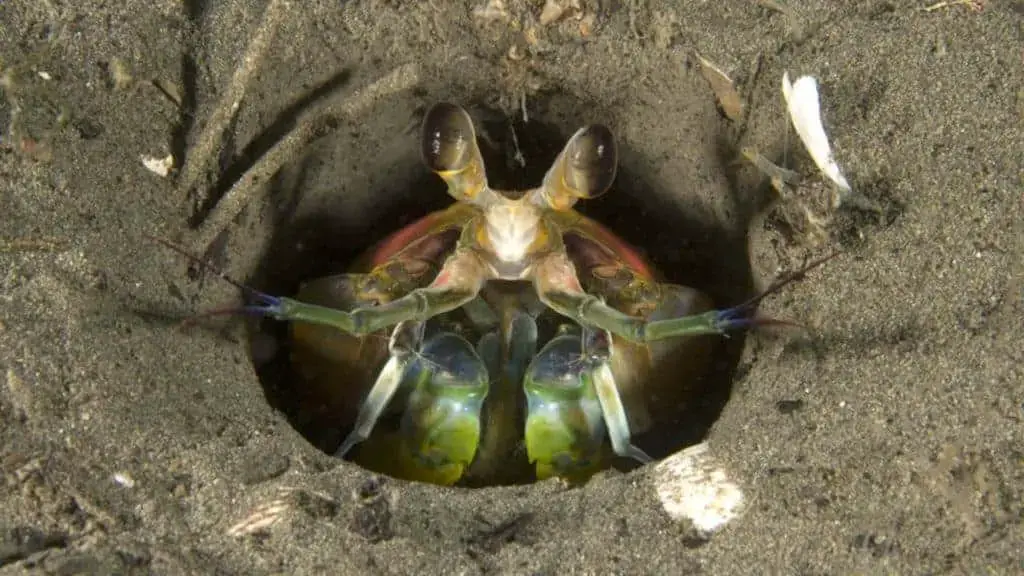
It’s quite amazing that Peacock Mantis Shrimps are known to stick with just one partner throughout their lives, so there will usually be just one male and one female partnering up during the breeding season.
It’s also amazing that female Peacock Mantis Shrimps are very devoted mothers to their offspring. The mothers will take care of their eggs and babies until they become independent so that their chances for survival will be high. While doing this, the females will even neglect to eat — just so she can look after her eggs or young ones.
What does the father Peacock Mantis Shrimps do when there are babies and young ones? They may not take care of their offspring like the mothers, but they guard their burrows and holes against intruders. If predators are planning to attack and eat their eggs and babies, the males will defend them with their powerful smashers.
How Long Do Peacock Mantis Shrimps Live?
A Peacock Mantis Shrimp can live for about four to six years.
Male Peacock Mantis Shrimp live longer than female Peacock Mantis Shrimp. Male Peacocks will live up to six years while female Peacocks can only live about two to four years.
This is because mantis shrimp males tend to be a little more aggressive towards each other, and there have been instances of male mantis shrimp fighting until one of them dies.
Tank size
Juvenile mantis shrimp can leave in about a 10-gallon tank. Bigger mantis shrimp (above 6 inches) are do best in an aquarium of 25 gallons or larger.
Population Status of Peacock Mantis Shrimps
Since the population status of Peacock Mantis Shrimps has not been evaluated yet, it’s hard to tell whether they are an endangered species.
Hopefully, there are still lots of them out there so that they will not be in danger of extinction soon. They will all be gone if they become extinct — and we don’t want that, right?
Fortunately, Peacock Mantis Shrimps can effectively defend themselves from predators with their smashers. However, keep in mind that there are other bigger creatures in the sea — so their smashers may not always work in defending themselves.
Peacock Mantis Shrimps as Pets
Needless to say, Peacock Mantis Shrimps make for attractive pets because they are colorful and interesting. However, they can also be hard to keep and maintain mainly because of their behavior.
Keep in mind that they are smashers — it’s easy for them to break glass tanks with their clubs. While this is their most impressive quality, it’s also their most destructive weapon. Some people even consider them a pest (not pets) because they can ruin corals. Since they are also natural hunters, they can even feed on the other inhabitants of a tank instead of living peacefully with them.
In Conclusion
Think twice when considering Peacock Mantis Shrimps as pets. It would be dangerous to keep them with other sea animals (even among the same species — as they will probably fight) and it would be impractical to use glass tanks. Other than those considerations, they really do make wonderful and interesting pets.

Hi, my name is Sean, and I’m the primary writer on the site. I’m blogging mostly about freshwater and saltwater aquariums, fish, invertebrates, and plants. I’m experienced in the fishkeeping hobby for many years. Over the years I have kept many tanks, and have recently begun getting more serious in wanting to become a professional aquarist. All my knowledge comes from experience and reading forums and a lot of informative sites. In pursuit of becoming a professional, I also want to inspire as many people as I can to pick up this hobby and keep the public interest growing.
Read more about Sean.
Please join also my Facebook group.

